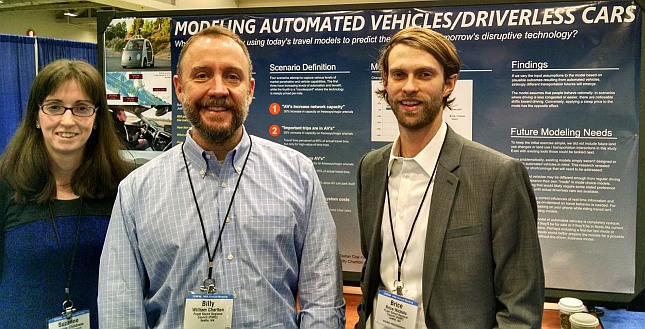
Transportation Research Board 2015 Annual Meeting
Every January at the Transportation Research Board (TRB) Annual Meeting, 12,000 transportation professionals get together and geek out about all things transportation. This year some members of our team presented about autonomous vehicles, household travel surveys, and moving research into practice. Obviously with such a huge conference, people are presenting about every possible facet of transportation like pavement, bikes, safety, and economics. This blog post focuses on some of our favorite discussions related to travel modeling and transportation planning.
Travel Time and Human Behavior
There were several fascinating studies of human travel behavior discussed this year. For example, we usually assume that people always find the shortest time path between home and work. However, we realize factors other than time do play a role in route choice. For example, some people prefer a more reliable, but slower route, or a route that avoids busy freeways or a particularly dangerous cross street. Other people might go well out of their way to avoid stop-and-go traffic, or even take a longer route to enjoy a scenic view. Travel modelers also love to talk about value of time and the perception of travel time. The topic is very complex to say the least, but here are a few more wrinkles we heard about at the conference.
Amanda Stathopoulus presented about “Modeling Travel Time Perception in Transport Mode Choices”. In household travel surveys, people report how long it takes to travel on their trips. Modelers have known for a long time that the reported times are highly inaccurate. This is partly due to inaccurate reporting, for instance, rounding to the nearest 5 minute or 15 minute increment, but the variations could actually tell a lot more about why the traveler chose their mode or a certain route. In other words, someone claiming a 30-minute commute only took 20 minutes implies they enjoyed their trip more than someone stating the same length commute took 45 minutes. Consider the perceptions of someone driving in stressful congestion for the same time as someone liesurely reading a book on a smooth-riding, empty train. Perhaps the time spent reading passing more quickly than time spent fighting traffic. Psychologists and behavioral economists frequently talk about time perception, but travel modeling hasn’t fully embraced the concept. We’re considering how to use our latest survey to find how people perceive their time differently by mode in the Puget Sound region.
This fun map below shows all the places you can get to by transit from a selected point within a certain amount of time. Note this shows actual time, not how people would actually perceive their time because of the conditions. Even on a bus, those conditions could be very different. For example, you could be sitting and playing a game on your phone or standing next to very sweaty neighbors while the bus creeps through traffic. This variation is important, but not easily captured to show simply on a map like this.
(credit: Mapnificent, Stefan Wehrmeyer)
Somewhat relatedly, Elizabeth Sall explained research by how people actually value their time differently depending on whether a travel route is congested or reliable. In modeling, we usually assume people value their time based on their income; so for example, if a route saves ten minutes of travel time, that is equivalent to $5 (or some number) for a person of a medium income group. These researchers actually showed, using GPS data, that people value their time more highly during congested conditions, presumably because the experience is worse. People also valued reliable time even higher because that ensures that they can arrive at their destination (like work or a doctor’s appointment) on time.
Rick Donnelly presented research by Soora Rasoli and Harry Timmermans about how people value activities while traveling. In modeling we usually assume that travel time is a dis-benefit; in other words, that people do not like time spent traveling. But this may not be the case in several circumstances. For example, if one can be productive, sleep, or read on commuter rail then at least some of the time may be a positive experience. I’ve also thought about this in terms of bicycling to work; some of this time is actually positive because it is a good way to get exercise, and is enjoyable.
Bigger Data in Travel Modeling
In travel modeling, we are just beginning our foray into using big data in practice. For the most part, we’re using the information to validate our models, as opposed to build them. David Ory described how they are going to use Clipper smart card data for validating where people board transit vehicles. In modeling we usually don’t validate travel times as much as we validate volumes. Ken Cervenka showed using google travel time data to district to district times, instead of simply district to district flows.
But the most exciting work with bigger data that I saw was the use of freight GPS data to develop freight trip tables. Aayush Thakur showed some of his team’s work to develop algorithms to take raw GPS data and make a trip table The reason I found this most interesting is that it is an actual way to create model inputs and a modeling framework using bigger data. It’s not just new validation; it’s a new technique.
If you were at TRB and saw something that really piqued your interest, feel free to comment below!
